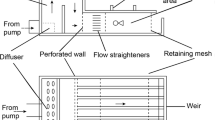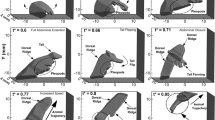Abstract
Many studies have shown that tail beat frequency of teleost fish is closely related to their swimming speed. These findings were developed further by Wardle1, who showed that maximum tail beat frequency and thus swimming speed could be predicted by measuring the twitch contraction time of the fast swimming muscles. The contraction time increases with the length of the fish and decreases with increase of temperature. Several authors have observed and recorded swimming speeds greater than the predicted speed limit. For example, Stevens and Neil2 report that skipjack tuna (Katsuwonus pelamis (L), length (L) 0.5 m) could swim at a speed of 10m s−1 at 32 °C, whereas the maximum predicted speed (extrapolating Wardle's1 data) was only 8m s−1. Walters and Fiersteine3 recorded a yellowfin tuna (Thunnus albacores (Bonnatare), L = 0.98m) moving at 20.8m −1 and Wahoo (Acanthocybium solandin (Cuvier), L = 1.13 m) at 21.4 m s−1. These two records show just twice the predicted maximum swimming speeds. Unfortunately no observations of the tail beat frequency were made during these high-speed swim records. Brill and Dizon4 have shown that five skipjack tuna (L 0.37–0.43 m) had muscle contraction times similar to non-scombroid teleost species of this size measured by Wardle1. It seems therefore that the tuna family (Scombridae) do not have faster maximum tail beat frequency than other teleosts of the same size and temperature. We show here how this paradox can be solved by the fish using a different swimming style, requiring greater power and efficient interaction between the propelling surfaces and the water, but allowing the fish to move twice as far for each tail beat.
This is a preview of subscription content, access via your institution
Access options
Subscribe to this journal
Receive 51 print issues and online access
$199.00 per year
only $3.90 per issue
Buy this article
- Purchase on Springer Link
- Instant access to full article PDF
Prices may be subject to local taxes which are calculated during checkout
Similar content being viewed by others
References
Wardle, C. S. Nature 255, 725–727 (1975).
Stevens, E. D. & Neil, W. M. in Fish Physiology 7 (eds Hoar, W. S. & Randall, D. J.) 316–361 (Academic, New York, 1978).
Walters, V. & Fiersteine, H. L. Nature 202, 208–209 (1964).
Brill, R. W. & Dizon, A. E. Envir. Biol. Fish 4, No 3 (1979).
Videler, J. J. & Wardle, C. S. Netherlands J. Zool. 28, 465–484 (1978).
Bainbridge, R. J. exp. Biol. 35, 109–133 (1958).
Hunter, J. R. & Zweifel, J. R. Fish Wild. Serv. Fish Bull. 69, 253–266 (1971).
Pyatetskiy, V. Y. in Hydrodynamic Problems of Bionics, Bionika No 4 (1970) translated from Russian JPRS 52605, 12–23. (National Technical Information Service, Washington DC 1971).
Hudson, R. C. L. J. exp. Biol. 58, 509–522 (1973).
Wardle, C. S. & Reid, A. in Fisheries Mathematics (ed. Steele, J. H.) 171–191 (Academic, New York 1977).
Magnuson, J. J. in Fish Physiology 7 (eds Hoar, W. S. & Randall, D. J.) 240–316 (Academic, New York, 1978).
Author information
Authors and Affiliations
Rights and permissions
About this article
Cite this article
Wardle, C., Videler, J. How do fish break the speed limit?. Nature 284, 445–447 (1980). https://doi.org/10.1038/284445a0
Received:
Accepted:
Issue Date:
DOI: https://doi.org/10.1038/284445a0
This article is cited by
-
Escape from the North Sea: the possibilities for pikeperch (Sander lucioperca L. 1758) to re-enter the Rhine and Meuse estuary via the Haringvlietdam, as revealed by telemetry
Journal of Coastal Conservation (2019)
-
Preparing to launch: biologging reveals the dynamics of white shark breaching behaviour
Marine Biology (2019)
-
Juvenile silver carp Hypophthalmichthys molitrix swim faster in closed surface flow than open surface flow
Environmental Biology of Fishes (2014)
-
Performance of motor systems in Antarctic fishes
Journal of Comparative Physiology A (1984)
Comments
By submitting a comment you agree to abide by our Terms and Community Guidelines. If you find something abusive or that does not comply with our terms or guidelines please flag it as inappropriate.



